Abstract
Low frequency audible vibrations are produced by human skeletal muscles undergoing sustained contraction. The effect is easily demonstrable with an electronic stethoscope which amplifies sound below 50 Hz. Autocorrelation analysis of the signal shows that it is periodic with a frequency 25 +/- 2.5 Hz. The quality of the sound is the same for all the skeletal muscles tested and is unaffected by changes in tension, ambient temperature, and blood flow. Electrically-stimulated contraction produces a sound which is indistinguishable from voluntary contraction. The amplitude of the sound increases linearly with tension. The sound signals are uncorrelated both in frequency and phase with electromyographic signals obtained simultaneously while the muscle is contacted. Arguments are presented to show that the sounds may be an intrinsic property of muscle contraction.
Full text
PDF

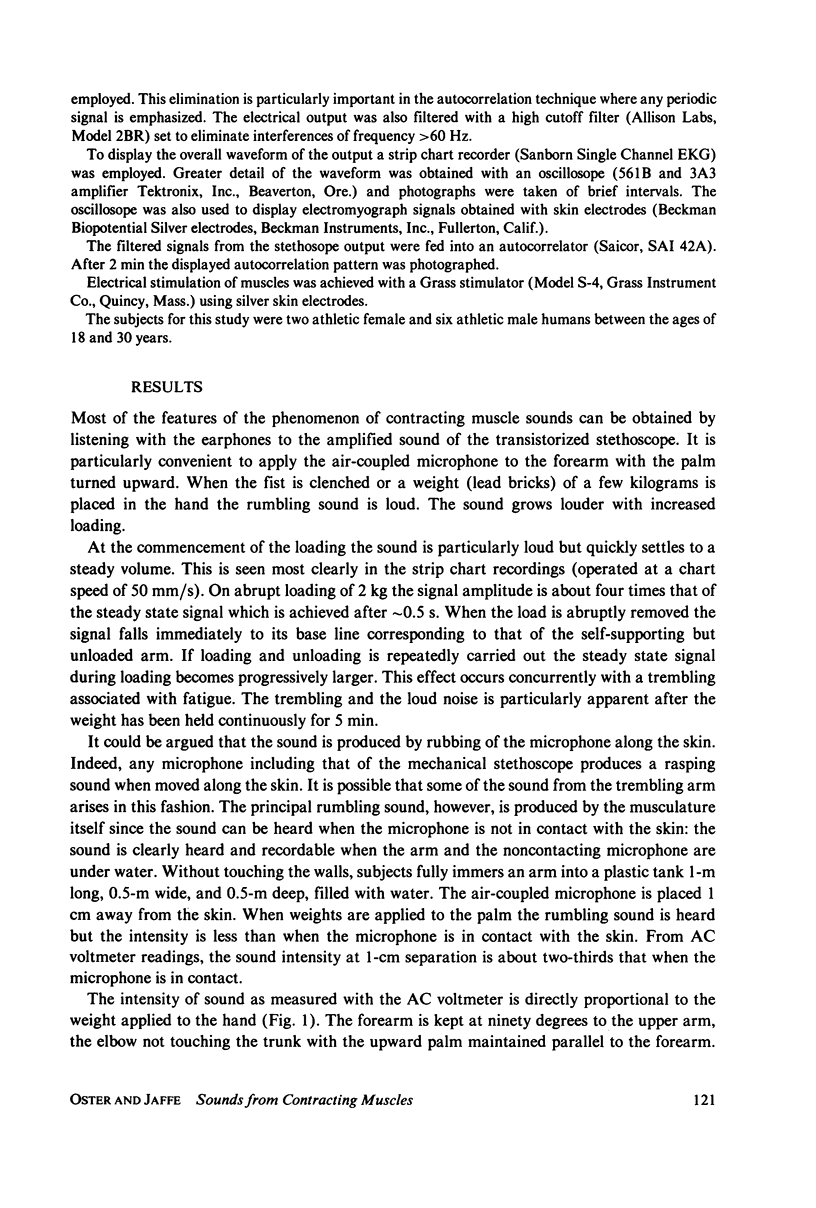
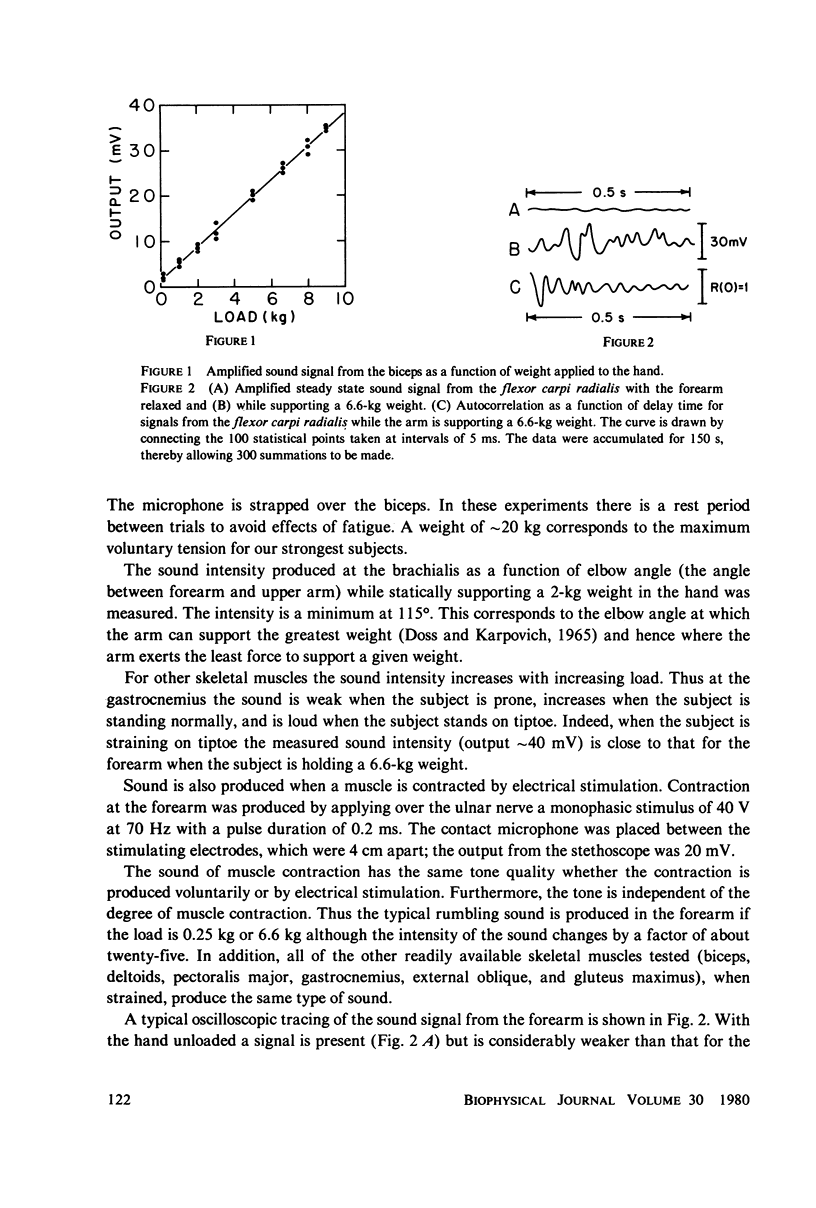
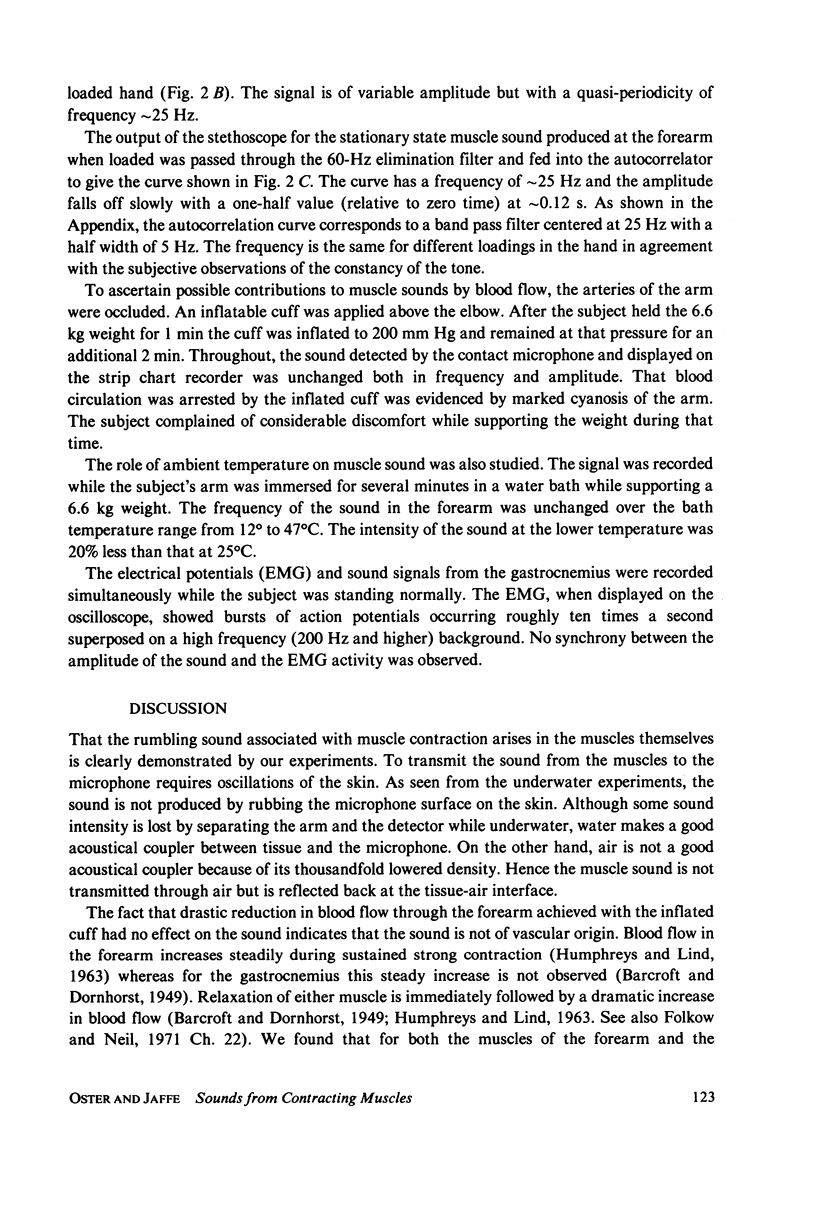

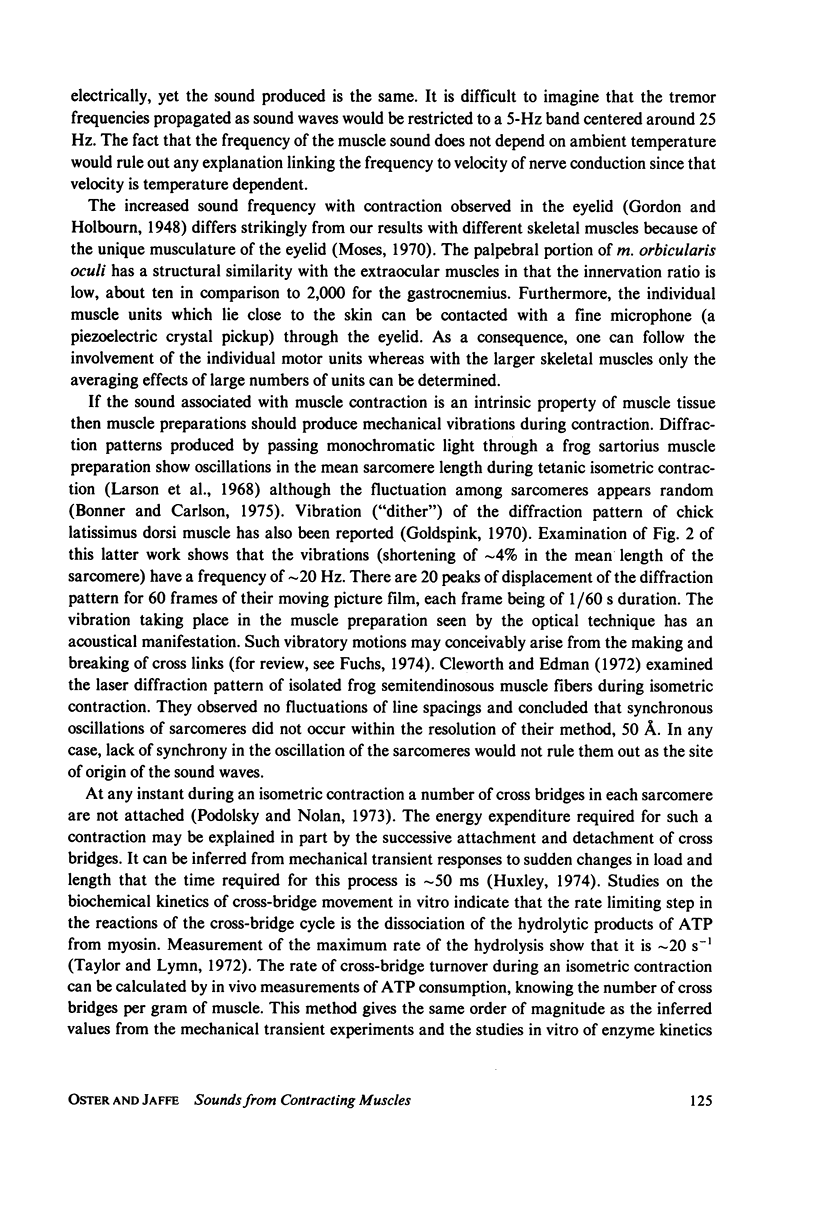

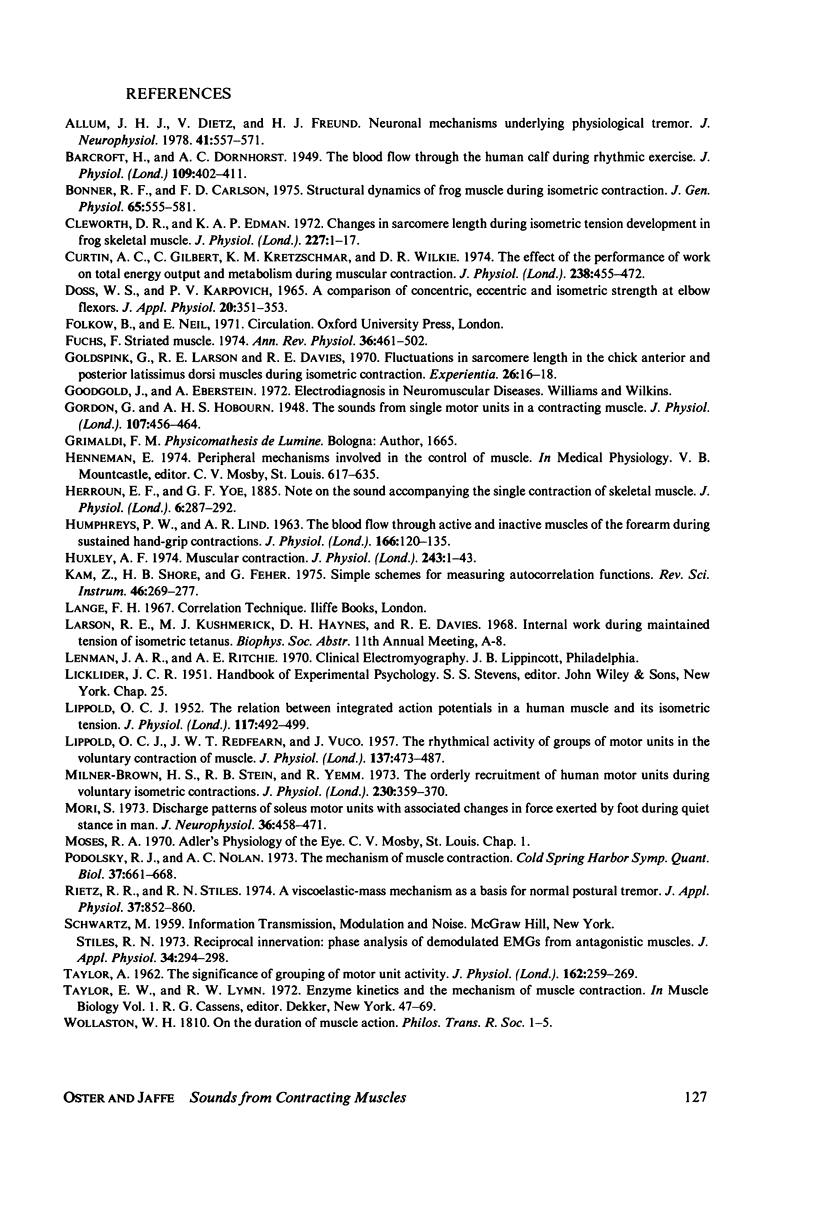
Selected References
These references are in PubMed. This may not be the complete list of references from this article.
- Allum J. H., Dietz V., Freund H. J. Neuronal mechanisms underlying physiological tremor. J Neurophysiol. 1978 May;41(3):557–571. doi: 10.1152/jn.1978.41.3.557. [DOI] [PubMed] [Google Scholar]
- BARCROFT H., DORNHORST A. C. The blood flow through the human calf during rhythmic exercise. J Physiol. 1949 Sep;109(3-4):402-11, pl. doi: 10.1113/jphysiol.1949.sp004403. [DOI] [PMC free article] [PubMed] [Google Scholar]
- Bonner R. F., Carlson F. D. Structural dynamics of frog muscle during isometric contraction. J Gen Physiol. 1975 May;65(5):555–581. doi: 10.1085/jgp.65.5.555. [DOI] [PMC free article] [PubMed] [Google Scholar]
- Cleworth D. R., Edman K. A. Changes in sarcomere length during isometric tension development in frog skeletal muscle. J Physiol. 1972 Dec;227(1):1–17. doi: 10.1113/jphysiol.1972.sp010016. [DOI] [PMC free article] [PubMed] [Google Scholar]
- Curtin N. A., Gilbert C., Kretzschmar K. M., Wilkie D. R. The effect of the performance of work on total energy output and metabolism during muscular contraction. J Physiol. 1974 May;238(3):455–472. doi: 10.1113/jphysiol.1974.sp010537. [DOI] [PMC free article] [PubMed] [Google Scholar]
- Goldspink G., Larson R. E., Davies R. E. Fluctuations in sarcomere length in the chick anterior and posterior latissimus dorsi muscles during isometric contraction. Experientia. 1970 Jan 15;26(1):16–18. doi: 10.1007/BF01900361. [DOI] [PubMed] [Google Scholar]
- Gordon G., Holbourn A. H. The sounds from single motor units in a contracting muscle. J Physiol. 1948 Sep 30;107(4):456–464. doi: 10.1113/jphysiol.1948.sp004290. [DOI] [PMC free article] [PubMed] [Google Scholar]
- HUMPHREYS P. W., LIND A. R. The blood flow through active and inactive muscles of the forearm during sustained hand-grip contractions. J Physiol. 1963 Apr;166:120–135. doi: 10.1113/jphysiol.1963.sp007094. [DOI] [PMC free article] [PubMed] [Google Scholar]
- Herroun E. F., Yeo G. F. Note on the Sound accompanying the Single Contraction of Skeletal Muscle. J Physiol. 1885 Jul;6(4-5):287–292. doi: 10.1113/jphysiol.1885.sp000198. [DOI] [PMC free article] [PubMed] [Google Scholar]
- Huxley A. F. Muscular contraction. J Physiol. 1974 Nov;243(1):1–43. [PMC free article] [PubMed] [Google Scholar]
- LIPPOLD O. C. J. The relation between integrated action potentials in a human muscle and its isometric tension. J Physiol. 1952 Aug;117(4):492–499. doi: 10.1113/jphysiol.1952.sp004763. [DOI] [PMC free article] [PubMed] [Google Scholar]
- LIPPOLD O. C., REDFEARN J. W., VUCO J. The rhythmical activity of groups of motor units in the voluntary contraction of muscle. J Physiol. 1957 Aug 6;137(3):473–487. doi: 10.1113/jphysiol.1957.sp005828. [DOI] [PMC free article] [PubMed] [Google Scholar]
- Milner-Brown H. S., Stein R. B., Yemm R. The orderly recruitment of human motor units during voluntary isometric contractions. J Physiol. 1973 Apr;230(2):359–370. doi: 10.1113/jphysiol.1973.sp010192. [DOI] [PMC free article] [PubMed] [Google Scholar]
- Mori S. Discharge patterns of soleus motor units with associated changes in force exerted by foot during quiet stance in man. J Neurophysiol. 1973 May;36(3):458–471. doi: 10.1152/jn.1973.36.3.458. [DOI] [PubMed] [Google Scholar]
- Rietz R. R., Stiles R. N. A viscoelastic-mass mechanism as a basis for normal postural tremor. J Appl Physiol. 1974 Dec;37(6):852–860. doi: 10.1152/jappl.1974.37.6.852. [DOI] [PubMed] [Google Scholar]
- Stiles R. N. Reciprocal innervation: phase analysis of demodulated EMGs from antagonistic muscles. J Appl Physiol. 1973 Mar;34(3):294–298. doi: 10.1152/jappl.1973.34.3.294. [DOI] [PubMed] [Google Scholar]
- TAYLOR A. The significance of grouping of motor unit activity. J Physiol. 1962 Jul;162:259–269. doi: 10.1113/jphysiol.1962.sp006930. [DOI] [PMC free article] [PubMed] [Google Scholar]
- Taylor E. W., Lymn R. W. Enzyme kinetics and the mechanism of muscle contraction. Muscle Biol. 1972;1:47–69. [PubMed] [Google Scholar]


